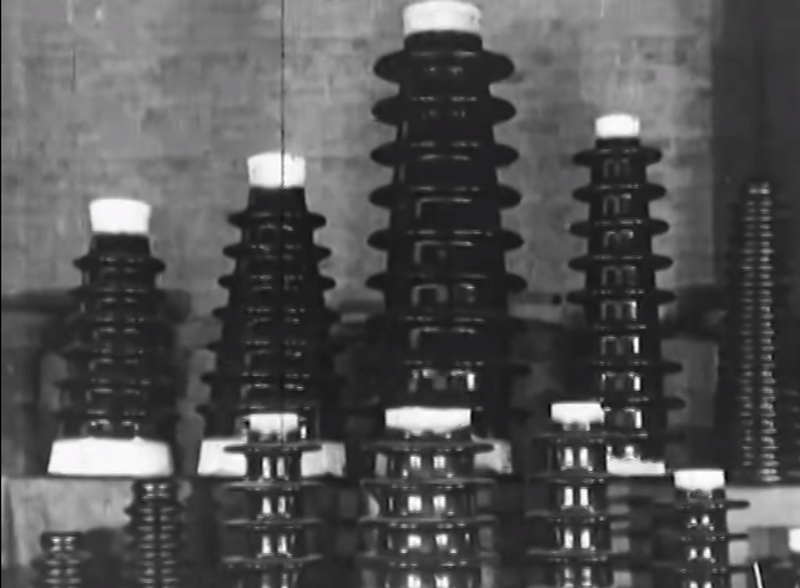Here is a silent film produced by General Electric that depicts the making of many kinds of porcelain insulators for power lines. Skilled craftsmen molded, shaped, and carved these vital components of the electrical grid by hand before glazing and firing them.
Porcelain insulators of this time period were made from china clay, ball clay, flint, and feldspar. In the dry process, ingredients are pulverized and screened to a fine powder and then pressed into molds, often with Play-Doh Fun Factory-type effects. Once molded, they are trimmed by hand to remove fins and flashing. The pieces are then spray-glazed while spinning on a vertical lathe.
Other types of insulators are produced through the wet process. The clay is mixed in a pug mill, which is a forgiving machine that takes scrap material of all shapes, sizes, and moisture levels and squeezes out wet, workable material in a big log. Chunks of log are formed on a pottery wheel or pressed into a mold. Once they are nearly dry, the pieces get their final shape at the hands of a master. They are then glazed and fired in a giant, high-temperature kiln.
http://www.youtube.com/watch?v=wenzDpwA9xA
Retrotechtacular is a weekly column featuring hacks, technology, and kitsch from ages of yore. Help keep it fresh by sending in your ideas for future installments.
















Wow. That brings back memories.
I used to have a job running a steam press making insulators. It was Bakelite (not ceramic), but it was exactly as shown in the video: pour a measured amount into a press, engage the press, wait 90 seconds, disengage, remove the part, rinse and repeat. (And scrape the fins off the previous part while you waited for the next one.)
Mind-numbing piecework for 8 hours a day in a factory with no AC. (Wouldn’t have helped – all the machines were steam driven and gave off heat like a radiator.)
One thing I noticed in the video: raw materials dumped on the floor, then employees had to shovel the material up into the hopper of the next machine.
With a bit of scaffolding and mounting the machines at different levels (and maybe some inclined conveyers) you could reduce the amount of work appreciably. Shoveling clay into a hole in the floor instead of up over shoulder height would be a lot easier.
I thought the same thing about the dumping/shoveling. There were a lot off inefficiencies in that video.
I also noticed that the women seemed to work a lot faster too…
The sad part is, that after they removed the inefficiencies and made one machine feed the other, a lot of simple jobs that anyone could do and get some $$ were also removed…
Jobs that anyone can do will always pay badly and will be removed ASAP.
Well it’s a hell of a long way from 3D printering, that’s for sure! Oh and it needs a soundtrack, like this industrial video…
https://www.youtube.com/watch?v=CXfxUVjHFl0
Can someone dub in some piano music? (c:
Like this?
http://www.youtubedoubler.com/?video1=https%3A%2F%2Fwww.youtube.com%2Fwatch%3Fv%3DwenzDpwA9xA&start1=29&video2=https%3A%2F%2Fwww.youtube.com%2Fwatch%3Fv%3DzBdHAiXZK4c&start2=6&authorName=snoopsagan
My high school clay class has a pugger. No clay is ever thrown away until it’s fired; some of that clay has been recycled for over ten years. It’s not uncommon to have a ruined project because of weird stuff in your clay. There are usually dozens of hairs, parts from the pugger’s wire mesh, pieces of paintbrushes, dried chips, and a frog.
Some fairly luxuriant mustaches in that video. And lots and lots of people shoveling, lifting and placing. Only in the last scene, does GE discover the conveyor belt.
I just like that there are probably a whole bunch of things that were made in that video still in service
I have some of these, about 4ft tall. good for laying around
Hi, Can someone please share share the video link or reupload it, Seems it is removed